Space Power is about the generation of power from space.
The space around Earth is filled with intense sunlight, undiffused by atmosphere, continuously. It represents an inexhausible supply of energy that can be converted to electricity using semiconductors - that is without the use of any moving parts.
A small fraction of this energy could supply a large part of the world's future energy requirements for the foreseeable future. In addition, it could do it without the need for any kind of fuel, and without producing any waste product.
All that's needed is large-area collectors - and that means large, thousands of square kilometers - and a way to transmit the collected power down to Earth. Several different methods are possible, but the one that has received the most effort so far is the use of microwave beams or wireless power transmission.- 29 July 2012
- Added "Space Debris and Its Mitigation
" to the archive.
- 16 July 2012
- Space Future has been on something of a hiatus of late. With the concept of Space Tourism steadily increasing in acceptance, and the advances of commercial space, much of our purpose could be said to be achieved. But this industry is still nascent, and there's much to do. So...watch this space.
- 9 December 2010
- Updated "What the Growth of a Space Tourism Industry Could Contribute to Employment, Economic Growth, Environmental Protection, Education, Culture and World Peace
" to the 2009 revision.
- 7 December 2008
- "What the Growth of a Space Tourism Industry Could Contribute to Employment, Economic Growth, Environmental Protection, Education, Culture and World Peace
" is now the top entry on Space Future's Key Documents list.
- 30 November 2008
- Added Lynx
to the Vehicle Designs page.
To receive announcements and news of updates by email, subscribe to the sf-announce mailing list.
Join the sf-discuss mailing list to ask questions and talk about space tourism, vehicles, power, and habitats.
More Info- Space-based Solar Power by 2016?
- When Stephen Hawking Speaks...
- Space-Based Solar Power, the PowerSat Way
- Space Frontier Foundation Submits SSP Whitepaper
- The 40th Anniversary of the Solar Power Satellite
- Mini-Documentaries on Space
- Why Space Solar Power Is Superior to Biomass Fuel
- Department of Defense Feasibility Study
- Space Solar Power Blog
- Global Warming...
- How Much Do You Know About Space
- Space Future Editor Wins NewSpace Journalism Award
- China's First Manned Docking of Space Module Is a Success
- Five Horrifying Facts
- NASA Will Pay You to Eat Astronaut Food
- Attention Teachers: If You Don't Apply to This Workshop
- Space Is Dirty
- The Film That NASA Banned
- SRI holds Inaugural Conference
- Zubrin's Proposal to Fund "Pathway to the Stars"
Here are some key documents from the archive to get you started:
- What the Growth of a Space Tourism Industry Could Contribute to Employment, Economic Growth, Environmental Protection, Education, Culture and World Peace
- Space Tourism Market Demand and the Transportation Infrastructure
- General Public Space Travel and Tourism
- Artificial Gravity and the Architecture of Orbital Habitats
- Prospects of Space Tourism
More Documents
|
| |
|
| |
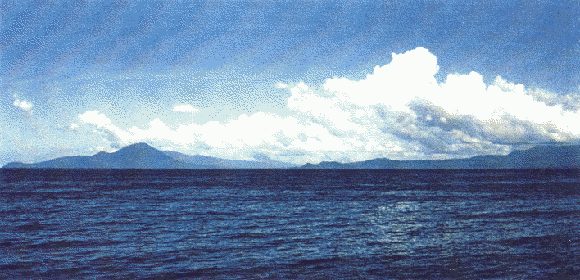 | |
|
The equatorial island of Halmahera in the Moluccas, seen from the west
Welcome to this Issue
In this 2nd issue of "Equatorial Times" we report on our recent visit to Indonesia (described at greater length in a separate Report) where we visited government offices in Jakarta, Satya Wacana University in Salatiga, and the island of Halmahera (see above) as a possible rectenna site. We also look at the question of the amount of energy that will actually be received by a rectenna. The output of the SPS 2000 satellite transmitting antenna is planned to be 10 MW of microwave energy. However, the users of the rectenna are more interested to know how many KWh of electricity per day they will be able to use - which is rather different, and quite complex to calculate, as explained in Estimating SPS 2000 rectenna energy output. Our discussions in Indonesia emphasized for us the importance of the views of potential rectenna-operating countries for the SPS 2000 project. International agreements govern the allocation of the electromagnetic spectrum between different uses and they have impacts on the technical design, and are of common interest to all countries considering hosting a rectenna. As more equatorial countries start to participate, their contribution will grow, and being the first customers for power from space they will have a key role in determining how the system may develop beyond the first satellite, as discussed in our Editorial. Plus SPS News from around the world, and another style of "mini-rectenna".
Estimating SPS 2000 rectenna energy output
For potential users of the energy to be produced by the SPS 2000 system, perhaps the most important parameter is the amount of electricity that will actually be available for users. This is the result of a chain of parameters between the transmitting antenna and the user, and is quite complex to calculate. On present plans the SPS 2000 satellite is being designed to transmit 10 MW of microwave energy in a narrow beam towards the Earth. However, the actual amount of power transmitted will vary continuously as the angle between the sun and the satellite solar panels changes, depending on the time of day, on the satellite attitude and on the season. Consequently the amount of microwave energy transmitted during each transmission period and cumulatively during each day will also vary. Of the energy in the beam, the amount reaching the rectenna will depend on the amount reaching the ground (which depends on the efficiency of transmission through the atmosphere - luckily almost 100%), and on the rectenna's area (assuming that the beam is pointed accurately towards the center of the rectenna). A rectenna some 2 km in diameter would be large enough to receive the whole beam, but the energy density at the edge of the beam will be only some 10% of that in the center, so it is less cost-effective to collect. Thus the size of each rectenna will be decided as a compromise between the demand for energy, the cost of land and rectenna construction, potential for later expansion, and other factors. 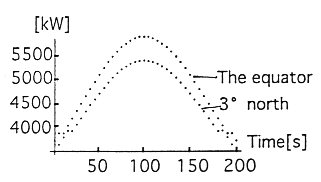
Variation in output of 1 km diameter rectenna through transmission period
Once the rectenna size is decided, the maximum power that will be received is fixed, but the power reaching the rectenna also changes during the transmission period: First, the distance between the satellite and rectenna changes by some 15% as it passes overhead, which changes the size of the microwave beam "footprint" on the ground. Second, the angle between the beam and the transmitting antenna changes by +/- 30 degrees, altering the angular width of the beam, and so the power-density. Finally there are several parameters related to the efficiency of the rectenna system: the efficiency of power conversion to DC; the efficiency of DC power collection and of storage; and the efficiency of energy delivery to customers. In order to design the electricity network to be used to supply customers it is essential to estimate these parameters and calculate the delivered energy as accurately as possible. Takeshi Shima studied this problem for his MSc Project at RCAST from 1994 to 1996. As part of his work he developed an easy-to-use computer program to calculate the energy received for different conditions - rectenna size, latitude, season, time of day, etc. This work is described in an English language paper presented at WPT2 but the Report and computer program are in Japanese. We will prepare English language versions soon. 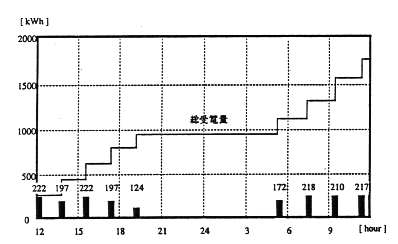
Possible energy storage during the day
Of course many of the parameters are not yet known accurately, but while the system design is under way we can put likely figures into such a computer model, and simulate the system reasonably well. As the system design progresses, the accuracy of these calculations will improve. In round figures the theoretical maximum which the satellite could deliver is some 555 KWh per period. In practice, allowing for the factors described above, the output of a rectenna 1 km in diameter will probably be some 200 KWh per delivery period, and cumulatively of the order of 1500 KWh per day. It is possible that future commercial SPSs will deliver microwave energy from geo-stationary orbit, so that there will not be problems of movement of the satellite and energy storage. But for the 1st experimental SPS we have no choice. To look on the bright side, if we can get SPS 2000 to work, a geostationary SPS may seem easy!
Field Research Around the Equator (4)*
| |
|
Using a grant awarded by the Japanese Ministry of Education, Science and Culture ("Monbushoh" in Japanese), field research to study the feasibility of siting SPS 2000 rectennas in equatorial countries has been under way since 1994. The objectives of this research are to make contact with colleagues in candidate countries; to have initial discussions with government representatives and other interested parties; to identify candidate rectenna sites; to develop preliminary ideas about appropriate rectenna designs for each site; and to consider how each rectenna might best be utilised. 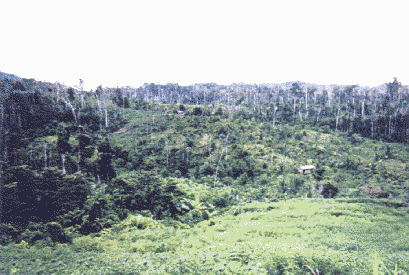
Typical steep woods on Halmahera
In March 1996, Dr Hideo Matsuoka and Dr Patrick Collins visited several government offices in the region near Jakarta including the Energy Technology Laboratoiy of the National Center for Research Science & Technology (PUSPIPTEK) of the Agency for the Assessment and Application of Technology (BPPT), the Indonesian Institute of Sciences (LIPI), the Directorate of Telecommunications (Depparpostel), the National Agency for Surveying and Mapping, and the National Institute of Aeronautics and Space (LAPAN). As in the three earlier field visits to Tanzania, Papua New Guinea and Brazil, there was considerable interest among officials in Indonesia in participating in the SPS 2000 project, both by hosting a rectenna and in other ways. Dr Collins then went to Salatiga to visit Satya Wacana Christian University where he met the SPS 2000 Study Group organized by Dr Yuliman Purwanto of the Department of Electronics. The final stage of the visit was to the Moluccas in north-east Indonesia, with visits to Ambon the capital, the island of Ternate, and finally Halmahera which straddles the equator. An island some 20,000 square kilometers in area, Halmahera is relatively sparsely populated, with only some 30,000-40,000 inhabitants. Few of these have access to electricity, and so this seems a suitable area for siting a rectenna. 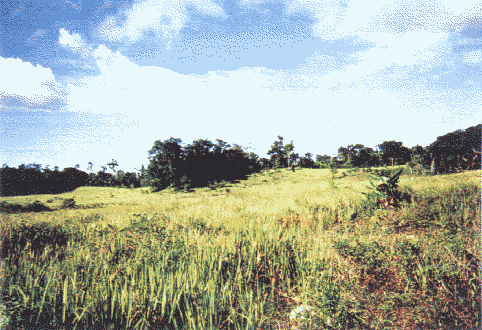
Unused open land on Halmahera
Issues arising
During the many discussions which took place a number of topics were identified as particularly important. First there is a need to assess both SPS and SPS 2000, to determine whether and in what ways participation could be beneficial for Indonesia. That is, although SPS and SPS 2000 are closely related, they axe separate issues. The question "Could SPS be an attractive energy source for Indonesia in the future, and if so, what aspects should Indonesian researchers focus on?" is separate from questions concerning SPS 2000. But conclusions about the potential attractiveness of SPS in general can influence decisions on how best to participate in SPS 2000. Second, like other countries already visited, some frequencies within the 2.4 - 2.5 GHz band defined by the lTU (International Telecommunications Union) as the Industrial Scientific & Medical (ISM) band, are used for communications in Indonesia. Thus there is a need to resolve any interference problems that SPS 2000 might cause for these tele-communication systems in Indonesia. Resolving these issues will involve the ITU. One possibility discussed was for an ITU study group to be established to consider SPS 2000, and/or for discussion of SPS 2000 at the next WARC (World Administrative Radio Conference) of ITU in 1997. Also, microwave noise from the SPS 2000 satellite will be received in every country near the equator, even countries which do not have a rectenna. Conversely, only these countries, not countries at higher latitudes, will be affected, since the SPS 2000 satellite uses a low orbit. Thus the equatorial countries have the potential to collectively play a unique role in the development of SPS 2000, and so in the development of SPS. Third, in view of the experience that already exists in Indonesia in planning and operating small-scale energy systems in remote locations, it may be attractive to combine an SPS 2000 rectenna with other local energy systems as part of a hybrid energy-system. Fourth, case-studies of rectenna system designs are to be performed for a number of possible sites on Halmahera and neighbouring islands. By comparing the various costs and benefits of each candidate site, much will be learned about their relative attractiveness, and their environmental and social impacts. 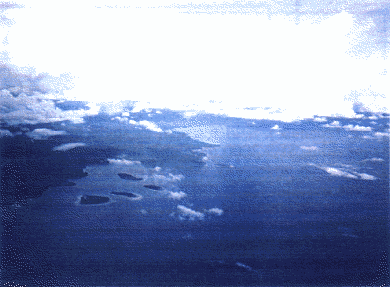
Uninhabited offshore islands
Fifth, members of the SPS 2000 Study Group at Satya Wacana University have decided to prepare a curriculum on the subject of SPS and SPS 2000. This should become a very valuable resource for increasing popular understanding of this topic. Today at many universities around the world there are dedicated engineering departments concerning different energy technologies such as hydro-electric engineering or nuclear engineering. In order for SPS to be recognised as a potentially major new energy source, it is necessary to increase the number of people who are knowledgeable about the many different aspects of the system. Fundamentally this is a question of education, and this project, which the SPS Working Group in Japan has agreed to assist, will be very valuable not only in Indonesia but in many other countries as well. This initiative is an example of the way in which, as the number of countries participating in SPS 2000 grows, their influence on the project also grows. Copies of the full report on our Indonesia visit are available on request. The next visit will be to Ecuador during October 1996.
Historical link between Indonesia and ISAS
During the visit to LAPAN, Dr. Ir. Adi Salatun, Deputy Chairman of Aerospace Technology Development, pointed out that Indonesia's launch site for sounding rockets at Pameungpeuk on the south coast of Java was established in 1963 by Professor Hideo Itokawa of Tokyo University, to launch "Kappa" sounding rockets. Professor Itokawa was the pioneer of Japanese rocket development, and Professor Nagatomo, the Director of the SPS 2000 project, was one of his last students. Dr Salatun said that Professor Itokawa is still warmly remembered for his contributions to Indonesia, and that he would invite members of the SPS 2000 Task Team who came to Indonesia in the future to visit the launch site at Pamenpeuk.
Language corner
SPS is an international project, so many different languages are involved. To date, in addition to Japanese and English, we have met Swahili, Pidgin, Portuguese and Indonesian, but in each country there are also many, many local languages. From time to time we will include this section concerning language. For such an international project English seems the most convenient language, but we must remember that this means "World English" which is read and spoken by hundreds of millions of people - not "perfect English", which is spoken by many fewer! Readers should not hesitate to send us material because they fear it may not be perfect. Since SPS 2000 started in Japan, most papers about the project are in Japanese. So we're starting by introducing a common Japanese phrase: "Shohganai" (pronounced in 5 syllables - Sho-u-ga-na-i). This means "Well, we don't really have any choice, so we may as well get on and not complain..." - so it's very useful! As an example, the problems that arise from putting the SPS 2000 satellite in low Earth orbit are an example of "Shohganai". The project would be easier if the satellite wasn't moving relative to the ground, but a geostationary satellite would cost far too much - so we can say "Shohganai!"
SPS 2000 'Home Page'
The SPS 2000 'Home Page' (or 'Web Site') on the Internet opened in July 1995. The address is: http://spss.isas.ac.jp inside the ISAS network. As everyone knows, the use of 'e-mail' (electronic mail) and the 'Internet' is growing rapidly around the world - particularly for exchanging information quickly and cheaply in research, business, leisure and the media. By sending information directly from computer to computer it saves a lot of time in outputting and inputting, and so makes cooperation much easier and quicker. | |
|
The SPS 2000 Home Page was set up by Yoshihiro Naruo in the Space Energy Engineering Division at ISAS. As those readers who have contacted it have seen, it contains illustrated system descriptions in Japanese and English, and lists more than 150 papers that have been published on different aspects of the project. It is hoped to upgrade the Home Page by including recent news; by translating more of the most recent information into English; by adding more papers - and even "Equatorial Times" - into the data-base*; etc. But this all takes time! But the best way to find out is to have a look at it yourself when you have a chance! In future it's likely that Internet communications will become increasingly important for the SPS 2000 project too.
SPS News
Opening of METLAB at Kyoto University
A new microwave energy transmission and reception laboratory was opened on June 21 in the Radio Atmospheric Science Center (RASC) led by Profesor Hiroshi Matsumoto. Recently awarded the designation as a Center of Excellence by the Ministry of Education, Professor Matsumoto's group at RASC has been active in SPS research since the 'MINIX' sounding-rocket experiment in 1983 which tested microwave transmission in the ionosphere. The new laboratory is 7 m wide x 7 m tall x 16 m in length, and is equipped for high power density experiments, which will enable a wide range of interesting work. We congratulate all those involved and look forward to good research results for SPS 2000!
International Symposium on Antennas and Propagation (ISAP)
The 6th ISAP will be held in Chiba from September 24-27. Two sessions on Microwave Power Transmission Technologies will be held on September 25th, at which 10 papers will be presented. 2 papers concern SPS 2000; 2 papers concern SPS more generally; one paper concerns research on biological impacts of microwaves, and 5 papers concern other aspects of wireless power transmission.
JSPS sponsored study-visit to Japan
Dr Yuliman Purwanto of Satya Wacana Christian University in Salatiga, Indonesia was sponsored by the Japan Society for the Promotion of Science (JSPS) to make a 1-month study visit to Japan in March and April this year. During that time he visited SPS researchers at the universities of Hokkaido, Kyoto, and Kobe, as well as RCAST and the Communications Research Laboratory (CRL) in Tokyo. Dr Purwanto was kept very busy during his stay! He made several presentations, and prepared papers on "A Preliminary Study of Rectenna Development Aspects in Indonesia for SPS 2000 Energy Reception", "SPS Study Program (A Preliminaiy Study for Indonesia)" and "SPS 2000 Study Program for Satya Wacana University". The proposal in this last paper is currently being put into effect, and is a most encouraging new direction for SPS work (see page 4). We look forward to receiving visitors from other partner countries when suitable opportunities (and funding!) arise.
First Student project on SPS in Papua New Guinea
Joseph Fisher, lecturer in the Department of Electrical & Communication Engineering at the Univesrity of Technology in Lae, tells us that a final year student is planning a microwave power transmission experiment, using a waveguide and mini-rectenna. We look forward to hearing the results, and we hope that this becomes the start of a growing effort.
International Conference on WPT / SPS to be held in Montreal, October 1997
Following the successful 2nd WPT conference held at Kobe University in October 1995 it was decided to hold WPT 3 in Montreal in October 1997, in combination with SPS 97 (a follow-up to SPS 91 in Paris). The proceedings of WPT2 are to be published in 'Space Energy & Transportation' Volume 1.
3rd Application for SPS Research Funding Unsuccessful
In early 1996 an application was made to the Ministry of Education, Science and Culture for funding of a co-ordinated SPS research plan by members of the SPS Working Group. As on the previous two occasions on which applications were made in 1995 and 1994, this year's application was also not successful. This is very disappointing. There is a view that because SPS 2000 work involves 4 different fields: Energy, Environment, Space Technology and Overseas Development, no one of these fields is solely responsible, and so none support it strongly. Consequently it seems that there may be a need for a different approach to funding SPS work.
'RIO' Conference Follow-Up Meeting
A follow-up meeting to the 1992 UN Conference on Environment and Development held in Rio de Janeiro is to be held in Tokyo in March 1997. In 1992 there was also a mini-conference "SPS RIO 92", and it is hoped that such a conference can be arranged in Tokyo too, in order to bring the potential of SPS and SPS 2000 to the attention of those concerned with these problems.
Recent SPS 2000 papers
Of the 26 papers presented at the 15th ISAS Space Energy Symposium in February, 8 concerned SPS 2000. An overview paper on SPS 2000 was also presented at SPACE 96 in Albuquerque in June.
Mini-Rectenna Corner
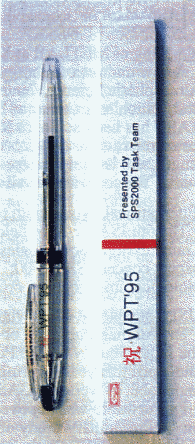
Pen-type mini-rectenna
The photograph shows a pen-type "mini-rectenna" made at ISAS. It contains a single dipole connected to a diode and an LED. When held close in front of the closed door of an operating microwave oven, the LED lights up - demonstrating wireless power transmission. That is, microwave power leaking through the door is absorbed by the dipole, rectified by the diode and the DC current drives the LED. This design does not use a reflector panel behind the dipole like the mini-rectenna shown in the last issue, and so the efficiency is rather low, as the proportion of microwaves absorbed is low. Consequently it hghts up only if held within a few cm of the door. Mini-rectennas are a good way of demonstrating WPT and explaining the concept of SPS. They are also very cheap to make! The diode costs 20 yen, the LED costs Y100, and the rest is just a pen. We will be happy to help SPS 2000 researchers make their own mini-rectennas, by providing information and/or components. We particularly look forward to receiving photographs, or even better, examples, of mini-rectennas made by readers in different countries. Safety Note Some people, when they see a mini-rectenna being demonstrated, say: "Now I see that microwave ovens are dangerous, because microwaves leak out of them!" However, this conclusion is incorrect. Microwaves do leak from ovens, but their intensity is governed by an international safety standard. For exposure of the general public, the intensity of continuous-wave radiation at 2.45 GHz must be less than 10 W/sq m (= 1 mW/sq cm). Mini-rectennas can pick up microwave power at even less than this intensity, and convert it to DC electricity. So all ovens leak a certain amount within the safety limit, which is not dangerous.
Editorial - "SPS 2000 International"
Started as a study project in Japan, "SPS 2000" is becoming increasingly international. And the prospects are that it will eventually involve at least 10 countries - and possibly many more. The reason why SPS 2000 must become international is obvious. In order to successfully transmit useful quantities of microwave energy from low orbit to Earth, the active cooperation of equatorial countries is essential. So far we have been delighted by, and most grateful for, the hospitality and serious interest we have found in each country that we have visited. Staff from many different government offices, researchers, business-people, students and others have shown lively interest in the potential of SPS as a new energy source, and have been keen to see their countries participate in the SPS 2000 project. As these discussions continue, it is becoming clear that, as well as participating by finding a suitable site for a rectenna and agreeing to operate it, the equatorial countries will play a larger role in the project, in several different ways. First, obtaining the agreement of all the rectenna countries will depend on their technical review of the SPS 2000 system, with particular concern for potential electromagnetic interference from the microwave beam. This is a matter for the ITU, and will involve reaching a collective agreement among the equatorial countries. Second, as we have learned on our visits, each country's situation is different in many ways, and so the role that each equatorial country will play will depend on their preferences. As this occurs, and particularly as the prospects for funding brighten, the project will gradually "take on a life of its own". For example, Tanzania may choose to invite Kenyan and Ugandan researchers to participate in an "East African rectenna". Papua New Guinea may combine its rectenna with a plantation project. Brazil may plan a research programme on the ionospheric impacts of the microwave beam. In this case, as the number of participating countries increases and their contributions spread, a unique project structure will develop. Third, SPS 2000 is being designed to evolve further, and it is hoped that it will be followed by other satellites being put in the same and/or other orbits to deliver power to the same rectennas. That is, once the system is established and operating, rectenna operators will be able to use additional supplies of microwave energy from space - and they will be in a position to pay for them. In effect SPS 2000 rectenna operators will be the first market for microwave energy from space, and if the terms are right, satellite engineering companies will compete to try to supply them. In view of existing plans to build "constellations" of tens or hundreds of communications satellites, it seems likely that companies will try to supply this market too. This will involve negotiations on terms of supply, both technical and economic. Such systems may grow and spread to other countries than equatorial ones, since satellites in higher orbits will be able to deliver to higher latitudes. The economic calculations involved will be discussed in a future issue of "Equatorial Times", but if this process was successful, the first steps taken by SPS 2000 rectenna operators could lead in a steady progression all the way to commercial SPSs. Of course, behind such internationalization there remains the question of financing. How much might Japan be prepared to pay in order to carry out "SPS 2000 International"? At present we can only offer an opinion, but if there was consensus in the engineering community in Japan that the project would be successful, it seems likely that it would be worth funding even at a cost in excess of 100 billion yen ($1 billion). This is of the same scale as existing space projects (for example, the single flight of the Japanese HOPE-X re-entry vehicle is planned to cost Y150 billion) but in addition to space development it would also be valuable for both energy and environmental research. In addition, its role in overseas development should not be overlooked. As a source of electricity for many thousands of people in equatorial countries who currently do not have supplies, the benefits brought by rectennas would not be trivial (though they would be dwarfed by the supplies to which the project would lead in future.) Perhaps even more importantly, a project like this which involves detailed technical cooperation on a range of issues between Japan and the equatorial countries, would have a range of beneficial side-effects in stimulating technical collaborative contacts between these countries, which would be likely to lead to further business opportunities. Thus we feel confident that, if we can make a detailed international plan for a system that will demonstrate useful microwave power transmission from space to Earth, it will be funded. 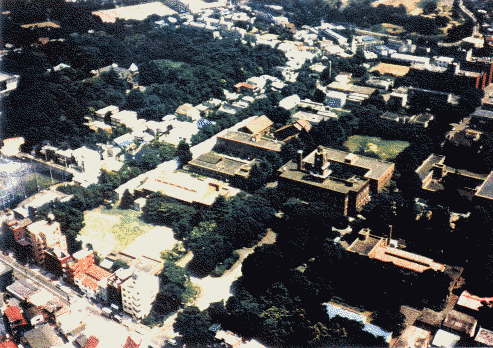
The Research Center for Advanced Science & Technology of the University of Tokyo, Komaba Campus in Meguro-ku, central Tokyo. The Field Research in equatorial countries for the SPS 2000 project is coordinated in the Human-made Environment Research Group under Dr Hideo Matsuoka.
Glossary of terms used
Next issue, December 1996:
For correspondence, contributions or further information, please contact Patrick Collins at: Research Center for Advanced Science & Technology, University of Tokyo, 4-6-1 Komaba, Meguro-ku, Tokyo 153, Japan.
| |


